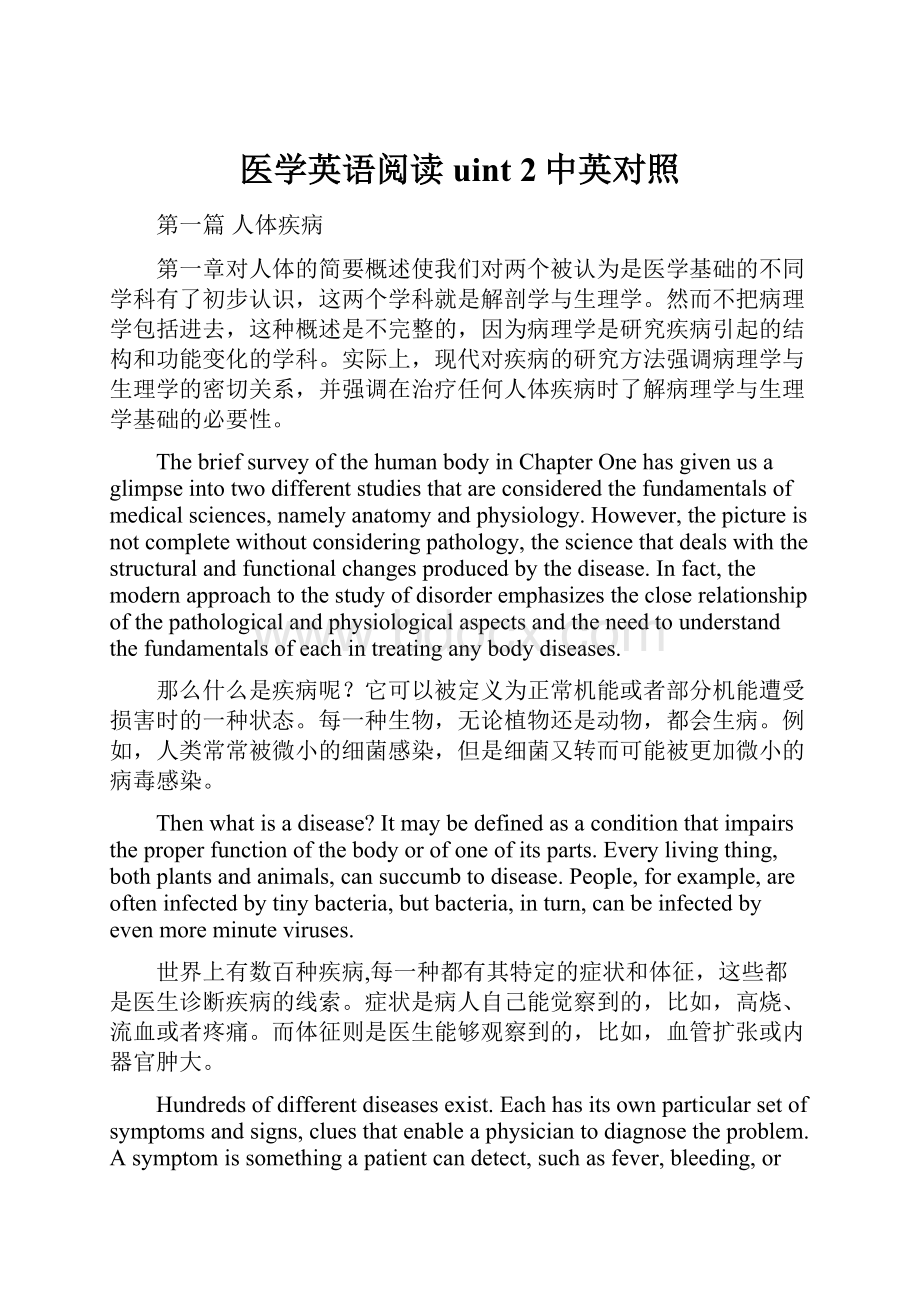医学英语阅读uint 2中英对照.docx
《医学英语阅读uint 2中英对照.docx》由会员分享,可在线阅读,更多相关《医学英语阅读uint 2中英对照.docx(23页珍藏版)》请在冰豆网上搜索。

医学英语阅读uint2中英对照
第一篇人体疾病
第一章对人体的简要概述使我们对两个被认为是医学基础的不同学科有了初步认识,这两个学科就是解剖学与生理学。
然而不把病理学包括进去,这种概述是不完整的,因为病理学是研究疾病引起的结构和功能变化的学科。
实际上,现代对疾病的研究方法强调病理学与生理学的密切关系,并强调在治疗任何人体疾病时了解病理学与生理学基础的必要性。
ThebriefsurveyofthehumanbodyinChapterOnehasgivenusaglimpseintotwodifferentstudiesthatareconsideredthefundamentalsofmedicalsciences,namelyanatomyandphysiology.However,thepictureisnotcompletewithoutconsideringpathology,thesciencethatdealswiththestructuralandfunctionalchangesproducedbythedisease.Infact,themodernapproachtothestudyofdisorderemphasizesthecloserelationshipofthepathologicalandphysiologicalaspectsandtheneedtounderstandthefundamentalsofeachintreatinganybodydiseases.
那么什么是疾病呢?
它可以被定义为正常机能或者部分机能遭受损害时的一种状态。
每一种生物,无论植物还是动物,都会生病。
例如,人类常常被微小的细菌感染,但是细菌又转而可能被更加微小的病毒感染。
Thenwhatisadisease?
Itmaybedefinedasaconditionthatimpairstheproperfunctionofthebodyorofoneofitsparts.Everylivingthing,bothplantsandanimals,cansuccumbtodisease.People,forexample,areofteninfectedbytinybacteria,butbacteria,inturn,canbeinfectedbyevenmoreminuteviruses.
世界上有数百种疾病,每一种都有其特定的症状和体征,这些都是医生诊断疾病的线索。
症状是病人自己能觉察到的,比如,高烧、流血或者疼痛。
而体征则是医生能够观察到的,比如,血管扩张或内器官肿大。
Hundredsofdifferentdiseasesexist.Eachhasitsownparticularsetofsymptomsandsigns,cluesthatenableaphysiciantodiagnosetheproblem.Asymptomissomethingapatientcandetect,suchasfever,bleeding,orpain.Asignissomethingadoctorcandetect,suchasaswollenbloodvesseloranenlargedinternalbodyorgan.
疾病可按不同的标准来分类。
例如,流行病是感染某一地区许多人的疾病。
当它年复一年地发生在同一地区,就成了一种地方病。
急性病发作快、病程短。
例如,急性心脏病发作常常没有前兆,而且会很快致命。
慢性病发病缓慢,但病程有时会长达数年。
风湿热正是由于发病慢、病程长而成为一种慢性病。
介于急性与慢性之间的另一种类型被称为亚急性。
Diseasescanbeclassifieddifferently.Forinstance,anepidemicdiseaseisonethatstrikesmanypersonsinacommunity.Whenitstrikesthesameregionyearafteryearitisanendemicdisease.Anacutediseasehasaquickonsetandrunsashortcourse.Anacuteheartattack,forexample,oftenhitswithoutwarningandcanbequicklyfatal.Achronicdiseasehasaslowonsetandrunsasometimesyears-longcourse.Thegradualonsetandlongcourseofrheumaticfevermakesitachronicailment.Betweentheacuteandchronic,anothertypeiscalledsubacute.
疾病也可以依其病原体来划分,例如,传染病指可以在人与人之间传播的疾病,如可通过咳嗽或打喷嚏造成的飞沫进行传播。
极小的有机体,如细菌和真菌,可导致传染病。
病毒和小虫子也可以。
不论病原体是什么,只要它存活于受感染的人体内就能传染给别人。
有时,一种致病菌侵入人体后,该人却没有显示患病的症状。
于是无症状的病原携带者甚至在自己也不知情的情况下就把疾病传染给了他人。
Diseasescanalsobeclassifiedbytheircausativeagents.Forinstance,aninfectious,orcommunicable,diseaseistheonethatcanbepassedbetweenpersonssuchasbymeansofairbornedropletsfromacoughorsneeze.Tinyorganismssuchasbacteriaandfungicanproduceinfectiousdiseases.Socanvirusesandtinyworms.Whateverthecausativeagentmightbe,itsurvivesinthepersonitinfectsandispassedontoanother.Sometimes,adisease-producingorganismgetsintoapersonwhoshowsnosymptomsofthedisease.Theasymptomaticcarriercanthenpassthediseaseontosomeoneelsewithoutevenknowinghehasit.
非传染性疾病是由身体机能失调引起的,这包括器官或组织退化、异常细胞生长以及异常的血液生成和血液循环。
当然也包括胃、肠、内分泌系统和泌尿生殖系统的紊乱。
一些疾病也可能由饮食不足、身体抵抗力下降或神经系统运行不良造成。
Noninfectiousdiseasesarecausedbymalfunctionsofthebody.Theseincludeorganortissuedegeneration,erraticcellgrowth,andfaultybloodformationandflow.Alsoincludedaredisturbancesofthestomachandintestine,theendocrinesystem,andtheurinaryandreproductivesystems.Somediseasescanbecausedbydietdeficiencies,lapsesinthebody’sdefensesystem,orapoorlyoperatingnervoussystem.
心理因素和社会因素也会引发残疾和疾病。
这些疾病包括毒品成瘾、肥胖、营养不良和由污染造成的健康问题。
Disabilityandillnessescanalsobeprovokedbypsychologicalandsocialfactors.Theseailmentsincludedrugaddiction,obesity,malnutrition,andpollution-causedhealthproblems.
而且,上千种乃至更多的遗传性出生缺陷由基因变异引起。
由于小小的基因负责产生许多身体所需的化学物质,它们的缺失或者运行不良都会严重损害健康。
影响人体化学反应的基因失调被称为先天性代谢失调,某些智力发育迟缓有遗传性。
Furthermore,athousandormoreinheritablebirthdefectsresultfromalternationsingenepatterns.Sincetinygenesareresponsibleforproducingthemanychemicalsneededbythebody,missingorimproperlyoperatinggenescanseriouslyimpairhealth.Geneticdisordersthataffectbodychemistryarecalledinbornerrorsofmetabolism.Someformsofmentalretardationarehereditary.
病菌如何侵袭身体
人类生活的世界里有许多其他生物为食物和繁衍而竞争。
很多致病生物,即病原体,通常被广义地称为病菌,能侵入人体并利用其细胞和液体来满足自己的需求。
一般来讲,身体防御系统能够抵抗这些入侵者。
Humansliveinaworldwheremanyotherlivingthingscompeteforfoodandplacestobreed.Thepathogenicorganisms,orpathogens,oftenbroadlycalledgermsthatcausemanydiseases,areabletoinvadethehumanbodyanduseitscellsandfluidsfortheirownneeds.Ordinarily,thebody’sdefensesystemcanwardofftheseinvaders.
病原体能通过多种方式进入人体。
一些病原体是被吸入人体的,如引起普通感冒、肺炎和结核病的病菌;有的是通过性接触进入人体的,如引起性病的病原体;还有的是通过受污染的食物、水或器皿进入人体,比如引起肝炎、霍乱和伤寒的病原体。
Pathogenicorganismscanenterthebodyinvariousways.Some—suchasthosethatcausethecommoncold,pneumonia,andtuberculosis—arebreathedin.Others—suchasthosethatcausevenerealdiseases—enterthroughsexualcontactofhumanbodies.Stillothers—suchasthosethatcausehepatitis,colitis,cholera,andtyphoidfever—getinthebodythroughcontaminatedfood,waterorutensils.
昆虫作为媒介或者病原体携带者传播疾病。
苍蝇能将病菌从人类的排泄物或其他腐烂的物质带到食物和饮料中;蚊子、虱子或其他媒介动物的叮咬也会将病菌传入人体。
Insectscanspreaddiseasebyactingasvectors,orcarriers.Fliescancarrygermsfromhumanwasteorothertaintedmaterialstofoodandbeverages.Germsmayalsoenterthebodythroughthebiteofamosquito,louse,orotherinsectvector.
身体如何抵抗疾病
作为第一条防线,健康的身体有许多物理屏障来抵御感染。
覆盖在体表或者器官开口处的皮肤和粘膜能在很大程度上抵抗细菌或其他感染体的入侵。
如果这些物理屏障遭到损坏或烧伤,身体对感染的抵抗力就会下降。
在一些较轻的病情中,可能只会发生疖子和丘疹。
在较重的情况下,身体的大面积区域则可能会被感染。
Asafirstlineofdefense,ahealthybodyhasanumberofphysicalbarriersagainstinfection.Theskinandmucousmembranescoveringthebodyorliningitsopeningsofferconsiderableresistancetoinvasionbybacteriaandotherinfectiousorganisms.Ifthesephysicalbarriersareinjuredorburned,infectionresistancedrops.Inminorcases,onlyboilsorpimplesmaydevelop.Inmajorcases,however,largeareasofthebodymightbecomeinfected.
呼吸道尤其容易受到感染。
幸好,呼吸道内覆盖了能分泌粘液的细胞,它们能捕获微生物和尘埃。
另外,呼吸道内覆有一层叫纤毛的细小绒毛,能象麦田里的小麦一样舞动,轻轻地将异物扫出呼吸道。
另外,呼吸道内的异物还常通过擤鼻涕、咳嗽、打喷嚏和清嗓子而被排出。
然而,反复感染、抽烟或其他原因会损坏呼吸道,使之容易受感染。
Breathingpassagesareespeciallyvulnerabletoinfection.Fortunately,theyarelinedwithmucus-secretingcellsthattraptinyorganismsanddustparticles.Also,minutehairscalledcilialinethebreathingpassages,wavelikeafieldofwheat,andgentlysweepmatteroutoftherespiratorytract.Inaddition,foreignmatterinthebreathingpassagescanoftenbeejectedbynoseblowing,coughing,sneezing,andthroatclearing.Unfortunately,repeatedinfection,smokingandothercausescandamagetherespiratorypassagewaysandmakethemmoresusceptibletoinfection.
很多潜在的入侵者不能在体温(华氏98.6度或摄氏37度)下生存。
即使能在这种温度下生存繁殖的病菌,在体温升高发烧时也会被杀灭。
Manypotentialinvaderscannotstandbodytemperature(98.6oFor37oC).Eventhosethatthriveatthattemperaturemaybedestroyedwhenthebodyassumeshigherfevertemperatures.
外耳道里的蜡质和泪管里的眼泪能减缓一些细菌的生长速度,而胃酸也能毁掉某种吞食进去的病菌。
Waxintheouterearcanalsandtearsfromeyeductscanslowthegrowthofsomebacteria.Andstomachacidcandestroycertainswallowedgerms.
身体的第二条防线是血液和淋巴。
某些白细胞群聚集在被感染区,通过形成脓肿使感染限于局部。
如果脓块不破裂,里面的脓不排出,感染很可能会扩大。
发生这种情况时,感染首先被该区域的淋巴腺阻挡。
例如,手上的感染向上传到手臂时,手臂上会出现红痕,腋窝淋巴腺肿胀,有触痛感。
如果感染得不到控制,将会导致血液中毒。
Thebody’ssecondlineofdefenseisinthebloodandlymph.Certainwhitebloodcellsflocktoinfectedareasandtrytolocalizetheinfectionbyformingpus-filledabscesses.Unlesstheabscessbreaksandallowsthepustodrain,theinfectionislikelytospread.Whenthishappens,theinfectionisfirstblockedbylocallymphglands.Forexample,aninfectioninthehandtravelsupthearm,producingredstreaksandswollen,tenderlymphglandsinthearmpit.Unlesstheinfectionisbroughtundercontrol,itwillresultinbloodpoisoning.
Phagocytesarelocatedatvarioussitestominimizeinfection.Onetypeinthespleenandliverkeepsthebloodclean.Othersinsuchhigh-riskareasasthewallsofthebronchiandtheintestinesremovecertainbacteriaandshatteredcells.
位于身体不同部位的吞噬细胞能最大程度地减少感染。
肝和脾内的吞噬细胞能保持血液清洁。
位于支气管壁和肠壁等高危区域的吞噬细胞能清除某些细菌和破碎的细胞。
第二篇诊断与预后
诊断
在大多数临床就诊过程中,病人会向医生提出一些基本的问题,例如:
“我怎么了?
”、“我的病是什么原因引起的?
”这些问题促使医生做出诊断,即确定生病的原因。
诊断包括病史、身体检查和实验室检查。
Inmostclinicalencounters,thepatientpresentsbasicquestionstothedoctor:
What’swrongwithme?
Whatiscausingmyillness?
Thesequestionssetthestageformakingadiagnosis,i.e.determiningthecauseofanillness.Andadiagnosisisaccomplishedwithhistory,physicalexaminationandlaboratorytesting.
疾病的诊断过程由采集病人的病史开始,医生向病人询问当前和过去所患的疾病、家族病史、生活习惯等等。
下表是一个标准病历应包含的内容。
Theprocessofdiagnosingadiseasebeginswiththeperson’shealthhistory.Thephysicianasksthepatientquestionsonbothpresentandpastillnesses,familyhistoryofdisease,habitsandsoon.Thefollowingtablepresentstypicalcontentsofastandardmedicalhistory.
病人的一般情况
年龄、性别、民族、职业和生育情况(适用于女性)
主诉
用四到五个字,最好是引用患者的自述,陈述就诊的目的及病痛的持续时间。
偶尔也可将患者的请求作为主诉,如:
“我需要注射流感疫苗”。
患者的其他医生
姓名、地址、电话号码以与患者的关系
现病史
每种主要症状,包括什么症状、发生部位、发生时间、轻重程度、时间
经过、症状好转或加重的影响因素、既往诊治情况及可能缩小诊断范围
相关的问题
既往史
既往疾病及住院情况、免疫情况、用药情况、过敏史、饮酒、吸烟及有无药物成瘾等
社会及职业史
描述患者日常生活中典型的一天以及目前疾病对其生活的影响;患者可获得的社会支持(来自家庭、朋友或同事)及职业史
家族史
家族中的遗传病史,家族成员的寿命及死亡原因
各系统的评估
主要器官系统的系统性评估:
皮肤、造血系统(包括淋巴结),头、眼、耳、鼻、口、喉、颈、乳房、呼吸系统、心血管系统、胃肠道系统、泌尿生殖系统、肌肉骨骼系统、神经系统、内分泌系统和精神系统
Descriptionofpatient
Age,gender,race,occupationandparity(forwoman)
Chiefcomplaint
Fourorfivewords,preferablyquotingthepatient,statingthepurposeofthevisitandthedurationofthecomplaint.Occasionallythepatientstatesarequestinsteadofacomplai